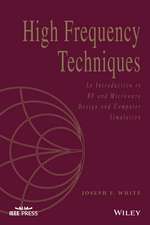Electromagnetic Field Theory for Engineers and Physicists
Autor Günther Lehner Traducere de Matt Horreren Limba Engleză Paperback – 26 noi 2014
The author presents how to apply numerical methods like finite differences, finite elements, boundary elements, image charge methods, and Monte-Carlo methods to field theory problems. He offers an outlook on fundamental issues in physics including quantum mechanics. Some of these issues are still unanswered questions. A chapter dedicated to the theory of special relativity, which allows to simplify a number of field theory problems, complements this book.
A book whose usefulness is not limited to engineering students, but can be very helpful for physicists and other branches of science.
| Toate formatele și edițiile | Preț | Express |
|---|---|---|
| Paperback (1) | 546.62 lei 6-8 săpt. | |
| Springer Berlin, Heidelberg – 26 noi 2014 | 546.62 lei 6-8 săpt. | |
| Hardback (1) | 663.79 lei 6-8 săpt. | |
| Springer Berlin, Heidelberg – 5 mar 2010 | 663.79 lei 6-8 săpt. |
Preț: 546.62 lei
Preț vechi: 643.08 lei
-15% Nou
Puncte Express: 820
Preț estimativ în valută:
104.60€ • 111.85$ • 87.21£
104.60€ • 111.85$ • 87.21£
Carte tipărită la comandă
Livrare economică 18 aprilie-02 mai
Preluare comenzi: 021 569.72.76
Specificații
ISBN-13: 9783642425295
ISBN-10: 3642425291
Pagini: 688
Ilustrații: XXVI, 659 p.
Dimensiuni: 155 x 235 x 40 mm
Greutate: 0.95 kg
Ediția:2010
Editura: Springer Berlin, Heidelberg
Colecția Springer
Locul publicării:Berlin, Heidelberg, Germany
ISBN-10: 3642425291
Pagini: 688
Ilustrații: XXVI, 659 p.
Dimensiuni: 155 x 235 x 40 mm
Greutate: 0.95 kg
Ediția:2010
Editura: Springer Berlin, Heidelberg
Colecția Springer
Locul publicării:Berlin, Heidelberg, Germany
Public țintă
GraduateCuprins
Maxwell#x2019;s Equations.- Basics of Electrostatics.- Formal Methods of Electrostatics.- The Stationary Current Density Field.- Basics of Magnetostatics.- Time Dependent Problems I (Quasi Stationary Approximation).- Time Dependent Problems II (Electromagnetic Waves).- Numerical Methods.
Notă biografică
Günther Lehner,
Studied mathematics and physics and afterwards, from 1957 through 1972, he held positions at various places, at the Technical University of Munich (Germany), the Institute for Plasma Physics in Garching near Munich (Germany), the Laborario Gas Ionizzati of Frascati near Rome (Italy). He researched in the area of plasma physics, thermonuclear fusion (fusion reactor), and highest magnetic fields. In 1961 he received his Ph.D. in the field of plasma physics and in 1967 his habilitation on topics of highest magnetic fields from the Technical University of Munich. In 1972 he was called to the University of Stuttgart (Germany) to head the department of Theoretical Electrical Engineering, to research and teach topics covering electromagnetic fields, energy conversion, and use of alternative energy sources, solar energy in particular. Emeritus in 1996.
Studied mathematics and physics and afterwards, from 1957 through 1972, he held positions at various places, at the Technical University of Munich (Germany), the Institute for Plasma Physics in Garching near Munich (Germany), the Laborario Gas Ionizzati of Frascati near Rome (Italy). He researched in the area of plasma physics, thermonuclear fusion (fusion reactor), and highest magnetic fields. In 1961 he received his Ph.D. in the field of plasma physics and in 1967 his habilitation on topics of highest magnetic fields from the Technical University of Munich. In 1972 he was called to the University of Stuttgart (Germany) to head the department of Theoretical Electrical Engineering, to research and teach topics covering electromagnetic fields, energy conversion, and use of alternative energy sources, solar energy in particular. Emeritus in 1996.
Textul de pe ultima copertă
This established, didactically excellent textbook unifies intuitiveness with extraordinary precision of its terminology and the derivation of concepts. It was developed as manuscript to teach students in electrical engineering, and has served to do so for thousands of students over two decades.
Discussed is the electromagnetic field theory and its mathematical methods. Maxwell’s equations are presented and explained. It follows a detailed discussion of electrostatics, flux problems, magnetostatics, quasi stationary fields, and electromagnetic waves.
The author presents how to apply numerical methods like finite differences, finite elements, boundary elements, image charge methods, and Monte-Carlo methods to field theory problems. He offers an outlook on fundamental issues in physics including quantum mechanics. Some of these issues concern still unanswered questions. A chapter dedicated to the theory of special relativity, which allows to simplify a number of field theory problems, complements this book.
This book’s usefulness is not limited to engineering students, but can also be very helpful for physicists and other branches of science.
Discussed is the electromagnetic field theory and its mathematical methods. Maxwell’s equations are presented and explained. It follows a detailed discussion of electrostatics, flux problems, magnetostatics, quasi stationary fields, and electromagnetic waves.
The author presents how to apply numerical methods like finite differences, finite elements, boundary elements, image charge methods, and Monte-Carlo methods to field theory problems. He offers an outlook on fundamental issues in physics including quantum mechanics. Some of these issues concern still unanswered questions. A chapter dedicated to the theory of special relativity, which allows to simplify a number of field theory problems, complements this book.
This book’s usefulness is not limited to engineering students, but can also be very helpful for physicists and other branches of science.
Caracteristici
The book convinces by its excellent didactics It is very precise regarding its conception and derivations The author depicts the electromagnetic field theory and the relevant mathematical methods Includes supplementary material: sn.pub/extras











